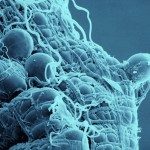Link to Pubmed [PMID] – 32118063
Link to DOI – 10.3389/fvets.2020.00040
Front Vet Sci 2020 ; 7(): 40
The causative agent of tick-borne fever and human granulocytic anaplasmosis, Anaplasma phagocytophilum, is transmitted by Ixodes ricinus, and is currently considered an emerging disease throughout Europe. In this study, we established a model of A. phagocytophilum sheep infection and I. ricinus transmission using the European Norway variant 2 ovine strain (NV2Os) propagated in both IDE8 and ISE6 tick cells. Two sheep were inoculated with IDE8 tick cells infected with NV2Os. Both sheep developed A. phagocytophilum infection as determined by qPCR and PCR, the presence of fever 4 days post inoculation (dpi), the observation of morulae in granulocytes at 6 dpi, and the detection of A. phagocytophilum antibodies at 14 dpi. A. phagocytophilum was detected by PCR in skin, lung, small intestine, liver, spleen, uterus, bone marrow, and mesenteric lymph node from necropsies performed at 14 and 15 dpi. One sheep was infested during the acute phase of infection with I. ricinus nymphs from a pathogen-free colony. After molting, A. phagocytophilum transstadial transmission in ticks was validated with qPCR positive bacterial detection in 80% of salivary glands and 90% of midguts from female adults. Infected sheep blood collected at 14 dpi was demonstrated to be able to infect ISE6 tick cells, thus enabling the infection of two additional naive sheep, which then went on to develop similar clinical signs to the sheep infected previously. One of the sheep remained persistently infected until 115 dpi when it was euthanized, and transmitted bacteria to 70 and 2.7% of nymphs engorged as larvae during the acute and persistent infection stages, respectively. We then demonstrated that these infected nymphs were able to transmit the bacteria to one of two other naive infested sheep. As expected, when I. ricinus females were engorged during the acute phase of infection, no A. phagocytophilum transovarial transmission was detected. The development of this new experimental model will facilitate future research on this tick-borne bacterium of increasing importance, and enable the evaluation of any new tick/transmission control strategies.

